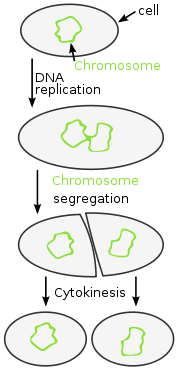- Fission (biology)
-
In biology, fission is the subdivision of a cell (or body, population, or species) into two or more parts and the regeneration of those parts into separate cells (bodies, populations, or species).[1][2][3] Binary fission produces two separate cells, populations, species, etc., whereas multiple fission produces more than two cells, populations, species, etc.
Contents
Binary fission of prokaryotes
Prokaryotic fission, which is binary fission, is a form of asexual reproduction and cell division used by all prokaryotes, (bacteria and archaebacteria), and some organelles within eukaryotic organisms. This process results in the reproduction of a living prokaryotic cell (or organelle) by division into two parts that each have the potential to grow to the size of the original cell (or organelle). This type of division takes place without the formation of spindles. The single DNA molecule first replicates, then attaches each copy to a different part of the cell membrane. When the cell begins to pull apart, the replicate and original chromosomes are separated. The consequence of this asexual method of reproduction is that all the cells are genetically equal, i.e have the same genetic material.
Multiple fission of protists
Multiple fission at the cellular level occurs in many protists. The nucleus of the parent cell divides several times by mitosis, producing several nuclei. The cytoplasm then separates, creating multiple daughter cells.[4][5][6] In apicomplexans, multiple fission is known as Protozoal merogony (sometimes treated to be synonymous with schizogony), Merogony results in merozoites, which are multiple daughter cells within the same cell membrane.[7][8]
See also
- Cytokinesis, cell division in eukaryotes
- Fission-fusion society, a type of social organization that is notable among primates
References
- ^ Carlson, B. M. (2007). Principals of regenerative biology.. Elsevier Academic Press. pp. 379. ISBN 0123694396.
- ^ Boulay, R. L.; Galarza, J. A.; Che, B.; Hefetz, A.; Lenoir, A.; van Oudenhove, L.; Cerda, X. (2010). "Intraspecific competition affects population size and resource allocation in an ant dispersing by colony fission.". Ecology 91 (11): 3312–3321. doi:10.1890/09-1520.1. http://www.esajournals.org/doi/full/10.1890/09-1520.1.
- ^ Hubbell, S. (2003). "Modes of speciation and the lifespans of species under neutrality: a response to the comment of Robert E. Ricklefs.". Oikos 100 (1): 193–199. doi:10.1034/j.1600-0706.2003.12450.x.
- ^ "Cell reproduction". Encyclopedia Britannica. http://www.britannica.com/EBchecked/topic/498542/reproduction/76146/Multiple-fission.
- ^ Britannica Educational Publishing (2011). Fungi, Algae, and Protists. The Rosen Publishing Group. ISBN 9781615304639. http://books.google.com.ph/books?id=_U9MB4iUpDIC&lpg=PA102&dq=multiple%20fission&hl=en&pg=PA101#v=onepage&q=multiple%20fission&f=false.
- ^ P.Puranik, Asha Bhate (2007). Animal Forms And Functions: Invertebrata. Sarup & Sons. ISBN 9788176257916. http://books.google.com.ph/books?id=-kdq6RyyVE0C&lpg=PA87&dq=multiple%20fission&hl=en&pg=PA87#v=onepage&q=multiple%20fission&f=false.
- ^ Lynn Margulis, Heather I. McKhann, Lorraine Olendzenski (1993). Illustrated glossary of protoctista: vocabulary of the algae, apicomplexa, ciliates, foraminifera, microspora, water molds, slime molds, and the other protoctists. Jones & Bartlett Learning. ISBN 9780867200812. http://books.google.com.ph/books?id=y55Efu3baksC&lpg=PA72&dq=Merogony%20multiple%20division&hl=en&pg=PA72#v=onepage&q=Merogony%20multiple%20division&f=false.
- ^ Yoshinori Tanada, Harry K. Kaya (1993). Insect pathology. Gulf Professional Publishing. ISBN 9780126832556. http://books.google.com.ph/books?id=99YwOQnsgGUC&lpg=PA415&dq=difference%20between%20merogony%20and%20schizogony&hl=en&pg=PA415#v=onepage&q=difference%20between%20merogony%20and%20schizogony&f=false.
Categories:
Wikimedia Foundation. 2010.

